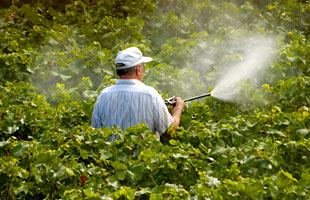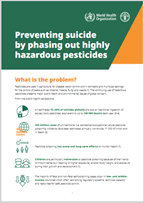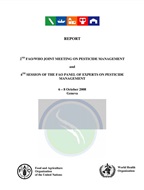Highly hazardous pesticides
Publication
The WHO Recommended Classification of Pesticides by Hazard and guidelines to classification,...
Short information document for decision makers
Tools

IOMC toolbox for decision-making in chemicals management

FAO Pesticides Registration Toolkit
Fact Sheet
Tools for action

More than 700 000 people lose their life to suicide every year. The world is not on track to reach the 2030 suicide reduction targets. WHO advocates for...
Detoxifying agriculture and health from highly hazardous pesticides -- A call for action
While all pesticides can be dangerous when used inappropriately, highly hazardous pesticides are of particular concern due to the severe adverse effects...
International Code of Conduct on Pesticide Management. Guidance for inspection of pesticide producers,...
The guidance is intended to be a practical, hands-on tool to assist government inspectors in preparing, conducting, recording, reporting and following-up...
Self-poisoning with pesticides causes up to one in five of the world’s suicides. Pesticide registrars and regulators have a key role to play in suicide...
Guidelines for procuring public health pesticides
Pesticide procurement is a highly specialized and complex subject. Expertise is required to ensure that appropriate high-quality pesticide products...
Guidelines for quality control of pesticides. International code of conduct on the distribution and use...
These guidelines cover the legislative, administrative, organizational and infrastructure (facilities and trained human resources) requirements...
Guidelines for the Registration of Pesticides. International Code of Conduct on the Distribution and...
The purpose of this document is to provide general advice on principles and process as well as requirements for registration of pesticides,...
Guidelines on pesticide advertising. International code of conduct on the distribution and use of pesticides
Advertising is the promotion of the sale and use of pesticides by printed and electronic media, signs, displays, gift, demonstration...
WHO-UNEP Sound management of pesticides and diagnosis and treatment of pesticides poisoning -- A resource...
This resource tool is intended to assist national programmes and those involved on management of pesticides, and with diagnosis and treatment of pesticide...
The aim of this document is to provide a general guidance for the establishment or strengthening of national pesticide quality control activities,...
Guidelines for predicting dietary intake of pesticide residues / prepared by the Global Environment Monitoring...
In 1989, guidelines for predicting dietary intake of pesticide residues were prepared by the Global Environment Monitoring System - Food Contamination...
Norms and guidance values
Most recent WHO evaluation and risk assessment documents
Educational material
Decision-making for the judicious use of insecticides -- Participant's and Facilitator's guide (Trial...
The goal of this course is to enable participants to make evidence-based decisions on the safe and judicious use of insecticides in public...
The application of pesticides on crops is necessary to prevent unacceptable losses of the agricultural production. However, their use may pose health risks...
Other relevant documents
IntroductionIn 2019, the Seventy-second World Health Assembly requested the WHO Director-General to prepare a menu of policy options and cost-effective...
This document provides the specifications for major pesticide application equipment used for control of vectors of diseases. The specification guidelines...
Generic risk assessment model for insecticides used for larviciding and mollusciciding — Second Edition
The purpose of this document is to provide a generic model that can be used for risk assessment of larviciding and mollusciciding; it aims to harmonize...
Manual on development and use of FAO and WHO specifications for pesticides. First edition - third revision
In 2001, the Food and Agriculture Organization of the United Nations (FAO) and the World Health Organization (WHO) agreed to develop specifications...
Specifications for pesticides: a training manual
The purpose of this course is to provide an introduction to the principles and practice of defining acceptable quality and equivalence of pesticides, to...
WHO pesticide evaluation scheme: 50 years of global leadership
Renewed interest by the international community and Member States in control of malaria vectors and the emergence of vector-borne diseases as a consequence...
Manual for indoor residual spraying application of residual sprays for vector control, third edition
Indoor residual spraying is used especially for control of malaria and Chagas disease vectors. However, where indoor residual...
Pesticides and their application : for the control of vectors and pests of public health importance,...
Vector control is an important component of many vector-borne disease control programmes. Its implementation includes targeted, site-specific...
A meeting of the Global Collaboration for Development of Pesticides for Public Health (GCDPP) on the development of guidelines for...
Space spray application of insecticides for vector and public health pest control : a practitioner's...
This guide provides information on how to control flying insect pests and vectors of diseases by applying insecticides as space treatments. Space treatments...
Reducing and eliminating the use of persistent organic pesticides: guidance on alternative strategies...
Persistent Organic Pollutants (POPs) are chemicals that persist in the environment, accumulate in high concentrations in fatty tissues and are bio-magnified...

